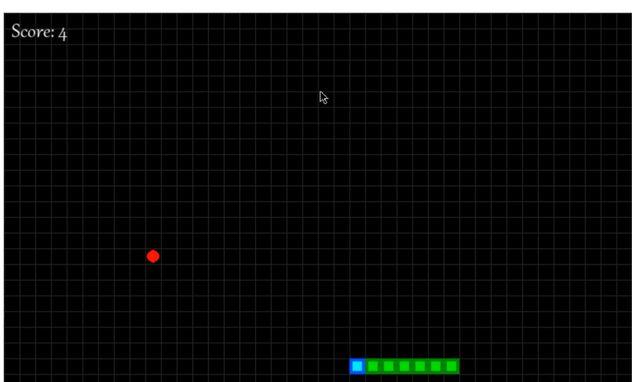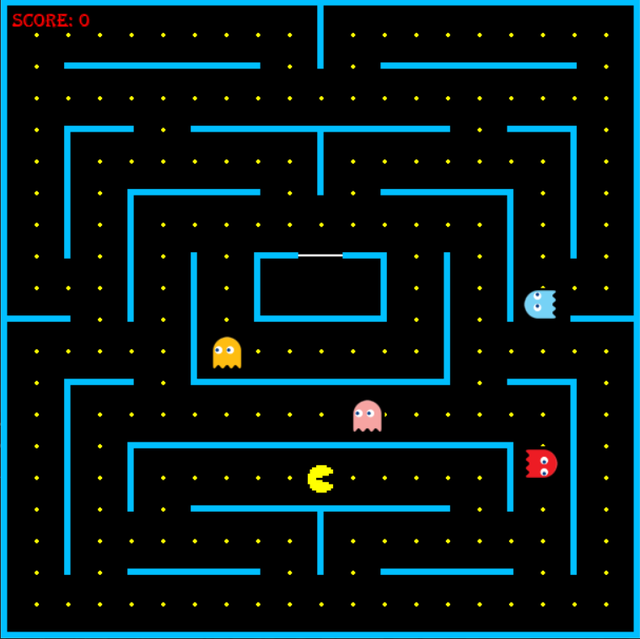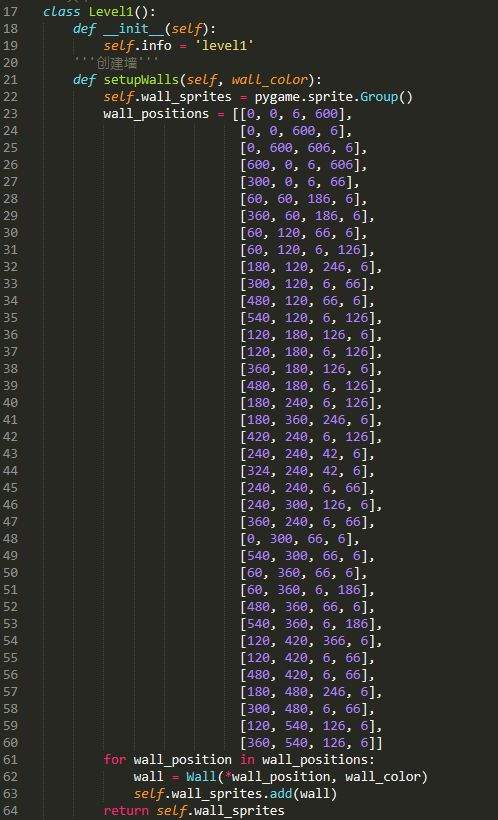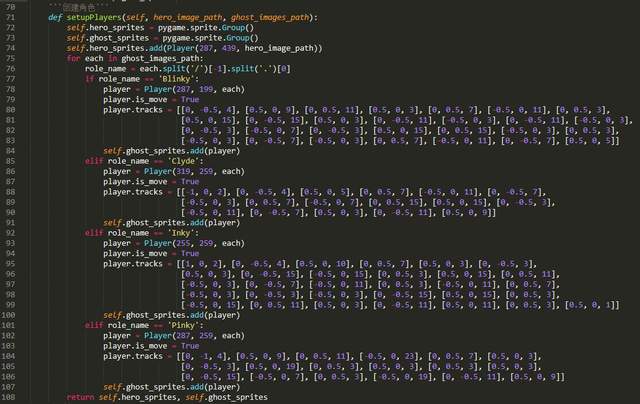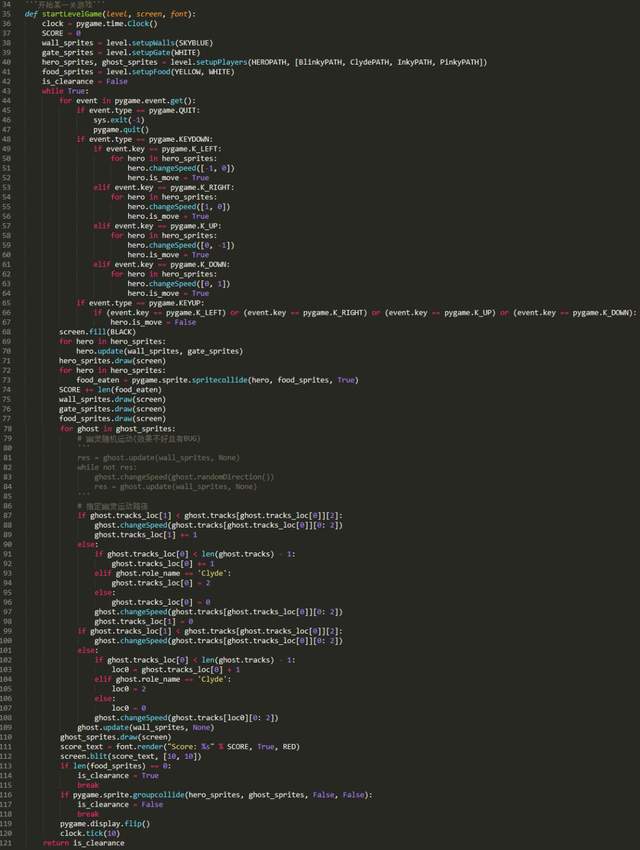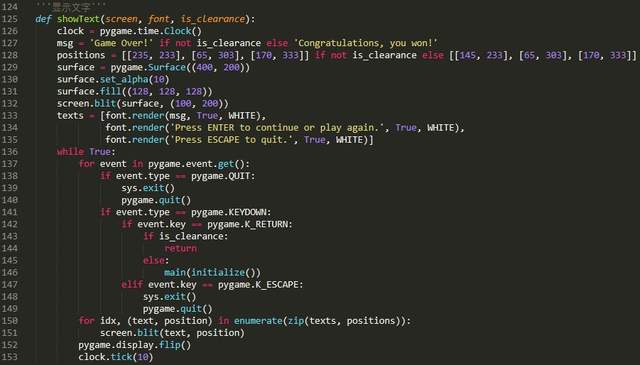Python游戏开发,Python实现贪吃蛇小游戏与吃豆豆 附带源码
开发工具
Python版本: 3.6.4
相关模块:
pygame模块;
以及一些Python自带的模块。
环境搭建
安装Python并添加到环境变量,pip安装需要的相关模块即可。
原理简介
贪吃蛇的游戏规则应该不需要我多做介绍了吧T_T。写个贪吃蛇游戏其实还是很简单的。首先,我们进行一下游戏初始化:
pygame.init()
screen = pygame.display.set_mode(cfg.SCREENSIZE)
pygame.display.set_caption('Greedy Snake —— 微信公众号:Charles的皮卡丘')
clock = pygame.time.Clock()
复制代码然后定义一个贪吃蛇类:
'''贪吃蛇类'''
class Snake(pygame.sprite.Sprite):
def __init__(self, cfg, **kwargs):
pygame.sprite.Sprite.__init__(self)
self.cfg = cfg
self.head_coord = [random.randint(5, cfg.GAME_MATRIX_SIZE[0]-6), random.randint(5, cfg.GAME_MATRIX_SIZE[1]-6)]
self.tail_coords = []
for i in range(1, 3):
self.tail_coords.append([self.head_coord[0]-i, self.head_coord[1]])
self.direction = 'right'
self.head_colors = [(0, 80, 255), (0, 255, 255)]
self.tail_colors = [(0, 155, 0), (0, 255, 0)]
复制代码其中head_coord用来记录蛇头所在位置,而tail_coords是一个二维数组,用来记录所有蛇身的位置。一开始,贪吃蛇长为3,并且位置是随机生成的。用户通过↑↓←→键来控制贪吃蛇的行动:
# --按键检测
for event in pygame.event.get():
if event.type == pygame.QUIT:
pygame.quit()
sys.exit()
elif event.type == pygame.KEYDOWN:
if event.key in [pygame.K_UP, pygame.K_DOWN, pygame.K_LEFT, pygame.K_RIGHT]:
snake.setDirection({pygame.K_UP: 'up', pygame.K_DOWN: 'down', pygame.K_LEFT: 'left', pygame.K_RIGHT: 'right'}[event.key])
复制代码需要注意的是,贪吃蛇不能180°大拐弯,只能90°地拐弯。例如正在向左行动的贪吃蛇不能瞬间变成向右行动。具体而言,代码实现如下:
'''设置方向'''
def setDirection(self, direction):
assert direction in ['up', 'down', 'right', 'left']
if direction == 'up':
if self.head_coord[1]-1 != self.tail_coords[0][1]:
self.direction = direction
elif direction == 'down':
if self.head_coord[1]+1 != self.tail_coords[0][1]:
self.direction = direction
elif direction == 'left':
if self.head_coord[0]-1 != self.tail_coords[0][0]:
self.direction = direction
elif direction == 'right':
if self.head_coord[0]+1 != self.tail_coords[0][0]:
self.direction = direction
复制代码然后,我们需要随机生成一个食物,且需要保证该食物的位置不与贪吃蛇的位置相同:
'''食物类'''
class Apple(pygame.sprite.Sprite):
def __init__(self, cfg, snake_coords, **kwargs):
pygame.sprite.Sprite.__init__(self)
self.cfg = cfg
while True:
self.coord = [random.randint(0, cfg.GAME_MATRIX_SIZE[0]-1), random.randint(0, cfg.GAME_MATRIX_SIZE[1]-1)]
if self.coord not in snake_coords:
break
self.color = (255, 0, 0)
'''画到屏幕上'''
def draw(self, screen):
cx, cy = int((self.coord[0] + 0.5) * self.cfg.BLOCK_SIZE), int((self.coord[1] + 0.5) * self.cfg.BLOCK_SIZE)
pygame.draw.circle(screen, self.color, (cx, cy), self.cfg.BLOCK_SIZE//2-2)
# 随机生成一个食物
apple = Apple(cfg, snake.coords)
复制代码在更新贪吃蛇的时候,如果它吃到了食物,则蛇身长加一,否则只是简单的按照给定的方向行动而不改变蛇身长度:
'''更新贪吃蛇'''
def update(self, apple):
# 根据指定的方向运动
self.tail_coords.insert(0, copy.deepcopy(self.head_coord))
if self.direction == 'up':
self.head_coord[1] -= 1
elif self.direction == 'down':
self.head_coord[1] += 1
elif self.direction == 'left':
self.head_coord[0] -= 1
elif self.direction == 'right':
self.head_coord[0] += 1
# 判断是否吃到了食物
if self.head_coord == apple.coord:
return True
else:
self.tail_coords = self.tail_coords[:-1]
return False
复制代码同时,当贪吃蛇吃到食物时,需要重新生成一个新的食物:
apple = Apple(cfg, snake.coords)
复制代码最后,当贪吃蛇碰到墙壁或者蛇头碰到蛇身时,游戏结束:
'''判断游戏是否结束'''
@property
def isgameover(self):
if (self.head_coord[0] < 0) or (self.head_coord[1] < 0) or \
(self.head_coord[0] >= self.cfg.GAME_MATRIX_SIZE[0]) or \
(self.head_coord[1] >= self.cfg.GAME_MATRIX_SIZE[1]):
return True
if self.head_coord in self.tail_coords:
return True
return False
复制代码并显示一下游戏结束界面:
endInterface(screen, cfg)
复制代码效果展示需要项完整目源的也可以点赞关注
经典吃豆豆小游戏原理简介
效果展示
游戏简介:
玩家通过↑↓←→键控制游戏的主角吃豆人吃掉藏在迷宫内的所有豆子,并且不能被鬼魂抓到。
若能顺利吃完迷宫内的所有豆子并且不被鬼魂抓到,则游戏胜利,否则游戏失败。
逐步实现:
Step1:定义游戏精灵类
首先,让我们先来明确一下该游戏需要哪些游戏精灵类。
① 墙类
② 食物类(即豆豆)
③ 角色类
角色类包括吃豆人和鬼魂,鬼魂由电脑控制其运动轨迹,吃豆人由玩家控制其运动轨迹。
显然,其均需具备更新角色位置和改变角色运动方向的能力,其源代码如下:
Step2:设计游戏地图
利用Step1中定义的游戏精灵类,我们就可以开始设计游戏地图了。由于时间有限,我只写了一个关卡的游戏地图,有兴趣的小伙伴可以在此基础上进行扩展(在我的源代码基础上进行扩展是很方便滴~)。游戏地图的设计包括以下四方面内容:
① 创建墙
② 创建门(一开始关幽灵用的)
image.gif
③ 创建角色
④ 创建食物
因为食物不能和墙、门以及角色的位置重叠,所以为了方便设计游戏地图,要先创建完墙、门以及角色后再创建食物:
Step3:设计游戏主循环
接下来开始设计游戏主循环。首先是初始化:
然后定义主函数:
其中startLevelGame函数用于开始某一关游戏,其源代码如下:
showText函数用于在游戏结束或关卡切换时在游戏界面中显示提示性文字,其源代码如下:
